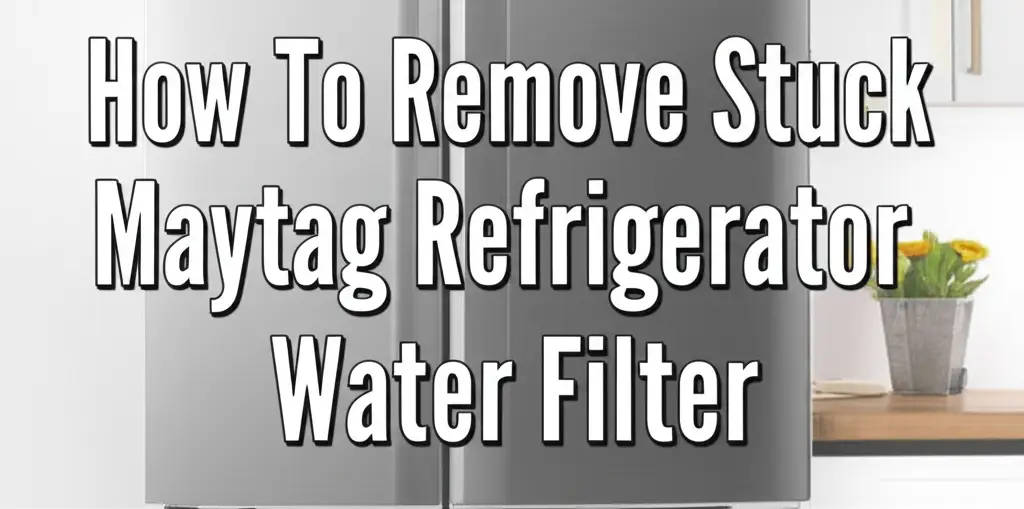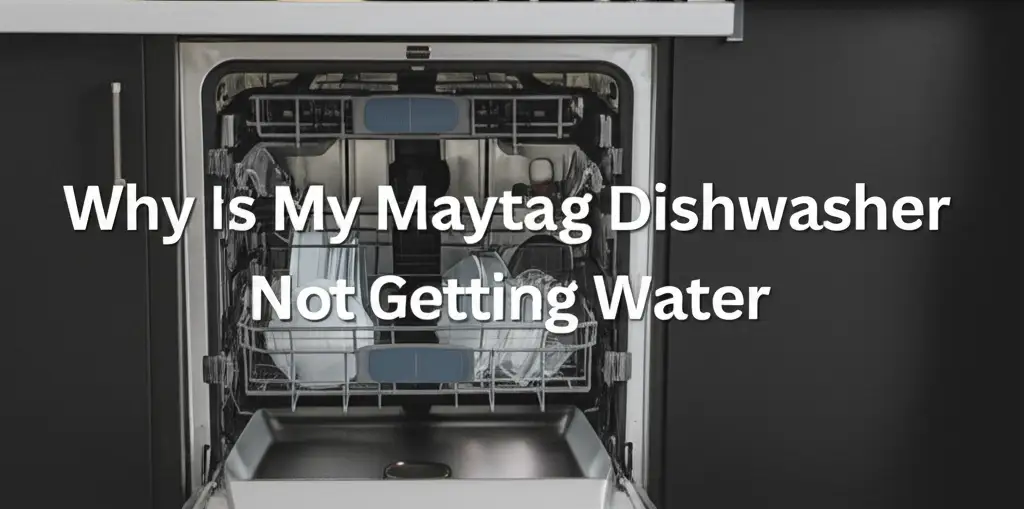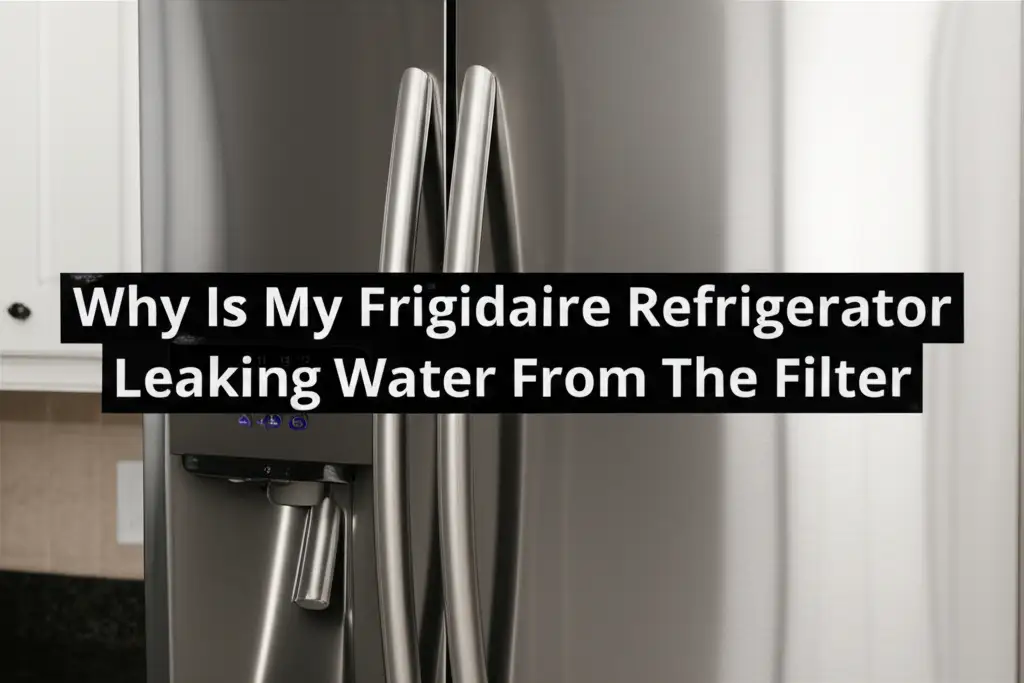· Todd Martin · Appliance Repair · 20 min read
How To Remove Stuck Maytag Refrigerator Water Filter

Unsticking Your Maytag Refrigerator Water Filter
Ever find yourself wrestling with a stubborn appliance? Many Maytag refrigerator owners face a common frustration: a water filter that simply will not budge. I understand how annoying it is when something meant for simple replacement becomes a major struggle. A stuck filter prevents you from getting fresh, filtered water. This problem also puts unnecessary strain on your appliance.
A properly functioning water filter is essential for clean drinking water. If you cannot remove a stuck Maytag refrigerator water filter, your water quality suffers. You might also experience reduced water flow or even leaks. This article will guide you through effective methods to safely remove your stuck filter. We will cover common reasons for filters getting stuck, the tools you need, and detailed, step-by-step instructions. You will also learn troubleshooting tips and prevention strategies. By the end, you will feel confident tackling this common household repair.
Takeaway:
- Turn off the water supply before attempting filter removal.
- Use appropriate tools like a strap wrench for better grip.
- Apply food-grade lubricant to the filter housing and seals.
- Twist firmly but gently, avoiding excessive force.
- Clean the filter housing and inspect seals before installing a new filter.
Concise Answer:
To remove a stuck Maytag refrigerator water filter, first shut off the water supply. Depressurize the water dispenser. Grip the filter firmly with a strap wrench if needed. Twist counter-clockwise with steady, increasing pressure. Applying food-grade lubricant around the filter base can help loosen stubborn seals, allowing for easier removal.
Why Maytag Refrigerator Water Filters Get Stuck
Understanding why your Maytag refrigerator water filter becomes stuck is the first step toward fixing the problem. Several factors contribute to this common issue. Knowing the cause helps you choose the right removal method. It also helps you prevent future occurrences.
One primary reason is overtightening during installation. When you put a new filter in, it is easy to twist it too tightly. People often want to ensure a secure seal. However, this excessive force compresses the O-rings inside the housing. Over time, these compressed O-rings can bond with the housing material. This makes removal extremely difficult. The filter effectively glues itself in place.
Another significant factor is mineral buildup and hard water deposits. If you live in an area with hard water, mineral deposits like calcium and magnesium can accumulate. These minerals build up around the filter and inside its housing. This calcification creates a tight bond. It acts like a cement, making the filter nearly impossible to twist or pull out. Regular filter changes can reduce this buildup. However, if ignored, it becomes a major problem.
Infrequent filter changes also play a role. Not replacing your filter regularly allows contaminants to accumulate. It also gives O-rings more time to swell and stick. Maytag recommends changing filters every six months. Waiting longer than this period increases the chances of the filter getting stuck. The plastic components can also warp slightly over extended periods. This contributes to the tight fit. The seals can also degrade and adhere to the housing.
Lastly, swollen O-rings or seals can cause a filter to stick. Over time, the rubber or silicone O-rings around the filter can absorb water. This causes them to expand slightly. This expansion creates an even tighter seal within the filter housing. When combined with friction from twisting, the swollen O-rings resist movement. This makes it challenging to break the seal and twist the filter free. All these factors often work together, making a simple filter change a frustrating task.
Essential Tools and Preparations for Filter Removal
Before you attempt to remove a stuck Maytag refrigerator water filter, gathering the right tools and preparing your work area is crucial. Proper preparation ensures both safety and efficiency. It helps prevent damage to your refrigerator. Having everything ready means you can focus on the task.
First, safety is paramount. Always disconnect your refrigerator’s power before starting any work. This prevents accidental shocks or damage to the appliance. Unplug the unit from the wall outlet. If unplugging is difficult, trip the circuit breaker that supplies power to the refrigerator. This step protects both you and the appliance.
Next, you need to turn off the water supply to your refrigerator. This step prevents water spills and potential flooding during the filter removal process. Most refrigerators have an inline shut-off valve behind the unit or under the sink. Turn the valve handle clockwise until it is completely closed. This stops water flow to the ice maker and water dispenser. If you are unsure where your shut-off valve is, find your home’s main water shut-off. While it is possible to change some filters without turning off the water, it is not recommended for a stuck filter situation. Using a different brand as an example, you can learn more about this by reading can you change an LG refrigerator water filter without turning off water. This extra precaution ensures no unexpected water flow.
After turning off the water, depressurize the water dispenser line. This is important to release any residual pressure in the system. Simply hold down the water dispenser lever for about 15-30 seconds. Water will trickle out at first, then stop completely. This action empties the line and prevents water from spraying when you remove the filter. Have a towel or small bucket ready to catch any drips.
Finally, gather your essential tools. These items will help you grip and manipulate the stubborn filter. You will need:
- Towels and a small bucket: To catch any water drips.
- Strap wrench or large channel lock pliers: A strap wrench is ideal as it provides excellent grip without damaging the filter’s plastic housing. Large channel lock pliers can also work if used with caution to avoid crushing the filter.
- Food-grade silicone lubricant spray or grease: This is critical for loosening seals. Do not use petroleum-based lubricants as they can damage plastic and rubber seals.
- Safety glasses: To protect your eyes from any unexpected sprays or debris.
- Gloves (optional): For better grip and to keep your hands clean.
Once you have completed these preparations, your workspace will be ready. You will be prepared to tackle the stuck filter problem safely and effectively.
Step-by-Step Guide: Safely Removing Your Stuck Maytag Water Filter
Removing a stuck Maytag refrigerator water filter requires patience and the correct technique. Do not use excessive force immediately. Instead, work systematically through the steps. This approach minimizes the risk of damaging the filter housing or the water lines.
Step 1: Double-Check Preparations. Confirm that your refrigerator’s power is disconnected. Ensure the water supply to the fridge is completely off. Dispense water from the front to relieve any remaining pressure. Place towels on the floor or shelf below the filter housing to catch spills. This groundwork is essential for a smooth process.
Step 2: Locate and Assess the Filter. Maytag refrigerators typically have filters located in one of two places:
- Inside the refrigerator compartment: Often at the top right corner. These are usually twist-out filters.
- In the base grille: Located at the bottom front of the refrigerator. These are often push-in and twist filters. Identify your filter type. Observe its position and how it’s oriented. Note the arrows or symbols indicating the lock and unlock positions.
Step 3: Attempt Manual Twisting (Gentle Force First). For twist-out filters, grip the filter firmly with your hand. Twist it counter-clockwise towards the unlock position. For push-in filters, push it in firmly first, then twist counter-clockwise. Apply steady, increasing pressure. If it gives even a little, keep twisting slowly. Sometimes, a gentle but firm twist is all it takes. Avoid jerking or sudden movements.
Step 4: Apply Food-Grade Lubricant. If the filter does not budge, lubricant is your next best friend. Spray or apply food-grade silicone lubricant around the base of the filter where it meets the housing. Pay special attention to where the O-rings are seated. This lubricant helps to break the bond of dried-on minerals and swollen O-rings. Let the lubricant sit for 5-10 minutes. This allows it to penetrate the tight seals. You might need to apply it a few times.
Step 5: Use a Strap Wrench or Pliers (With Caution). After applying lubricant, try twisting again. If it is still stuck, it is time for a tool.
- Strap Wrench: This is the safest option. Wrap the strap wrench around the filter, as close to the housing as possible. Tighten the strap for a secure grip. Apply steady, counter-clockwise pressure. The strap wrench distributes force evenly. This reduces the risk of crushing or damaging the filter housing.
- Channel Lock Pliers: If a strap wrench is unavailable, large channel lock pliers can work. Wrap a towel around the filter first to protect the plastic. Grip the filter firmly but not excessively tight. You do not want to crush it. Twist counter-clockwise. Use extreme caution to avoid damaging the housing. Apply consistent, firm pressure rather than jerky movements.
Step 6: Wiggle and Twist. Sometimes, a combination of twisting and a slight wiggling motion helps. As you twist counter-clockwise, try gently wiggling the filter. This can help break any remaining adhesions. Do not pull too hard outwards unless it is a pull-out type filter. Focus on the twisting motion required for Maytag models.
Step 7: Prepare for New Filter Installation. Once the stuck filter is out, inspect the housing. Clean any residue or mineral buildup from the inside of the housing and around the O-ring grooves. A small brush or cloth can help with this. You want a clean surface for your new filter. For general filter maintenance, you might want to learn how to clean water filter. This step prepares the housing for a smoother installation of the new filter. When inserting the new filter, apply a thin layer of food-grade silicone lubricant to its O-rings. This ensures easier future removal.
Remember, persistence is key. If the filter is extremely stubborn, take breaks. Reapply lubricant. Sometimes, allowing the lubricant more time to work makes a difference.
Troubleshooting Common Issues During Maytag Filter Removal
Even with the right tools and techniques, you might encounter additional challenges. A stuck Maytag refrigerator water filter can present unique problems. Knowing how to troubleshoot these issues helps you avoid further frustration or damage.
Issue 1: The filter still won’t budge after lubrication and tools. If your filter remains stubbornly in place, you might need to increase your efforts slightly.
- Reapply Lubricant and Wait Longer: Sometimes, the initial application of lubricant is not enough. Reapply the food-grade silicone lubricant generously. Let it sit for 30 minutes to an hour. This allows the lubricant more time to penetrate the seized O-rings and mineral buildup.
- Gentle Tapping: While twisting with your strap wrench, gently tap the side of the filter housing near the base with a rubber mallet or the handle of a screwdriver. The vibrations can sometimes help dislodge internal components or break a seal. Be very gentle. Too much force can crack the plastic housing.
- Heat (Extreme Caution): As a last resort, very carefully apply a small amount of heat. Use a hairdryer on a low setting, directed at the plastic housing around the filter base. Heat can cause plastic to expand slightly. This might loosen the filter. Do not use a heat gun. Apply heat for short bursts (15-30 seconds). Then try twisting. Overheating can warp or melt plastic. This can damage your refrigerator permanently. This method carries risks and should only be used if all else fails.
Issue 2: Water leaks after attempting removal or before replacing the new filter. Leaks can occur if seals are compromised or if the housing is damaged.
- Check O-Rings: Inspect the O-rings on the old filter (if removed) and inside the housing. Look for cracks, tears, or flattening. Damaged O-rings cannot create a proper seal. If you have a replacement filter, check its O-rings too.
- Inspect Filter Housing: Carefully examine the plastic filter housing for any cracks or damage. Excessive force during removal attempts can sometimes crack the housing. Even small cracks can lead to significant leaks. If the housing is cracked, you will need to replace the entire filter housing assembly. This is a more involved repair.
- Proper Installation of New Filter: A common cause for leaks after filter replacement is improper installation. Ensure the new filter aligns correctly with the housing. Twist it clockwise until it stops and locks into place. Do not overtighten. Over-tightening can damage the new O-rings or housing. If your Maytag refrigerator water dispenser is not working after replacing the filter, leaks are one possible cause. Learn more here: why is my Maytag refrigerator water dispenser not working after replacing filter. This linked article gives further insights into post-replacement issues.
Issue 3: The filter housing seems damaged or broken. If you suspect damage to the filter housing, do not force the filter further.
- Cease Operations: Stop trying to remove the filter immediately.
- Turn Off Water and Power: Ensure both are off to prevent leaks and electrical hazards.
- Assess Damage: Visually inspect the housing. If you see cracks, stripped threads, or broken plastic pieces, the housing assembly needs replacement. This is a more complex repair. It often requires ordering specific parts from Maytag or a reputable appliance parts supplier.
- Professional Help: In cases of significant damage, consider calling an appliance technician. Replacing a filter housing can involve disconnecting water lines. It might also require accessing internal refrigerator components. This is a job best left to professionals to avoid further costly damage. Leaks, particularly from the bottom of your appliance, can indicate a problem with the water lines or filter housing. Refer to why is my Maytag refrigerator leaking water from the bottom for more information on potential leak sources.
By systematically addressing these troubleshooting scenarios, you can either successfully remove your stuck filter or identify when professional help is necessary.
Post-Removal Maintenance and Prevention Tips
Successfully removing a stuck Maytag refrigerator water filter is a great achievement. However, your work is not over. Proper post-removal maintenance and implementing preventive measures are crucial. These steps ensure your new filter goes in smoothly. They also help prevent future filters from getting stuck.
First, clean the filter housing thoroughly. Once the old filter is out, take time to clean the internal parts of the housing. Use a damp cloth to wipe away any dirt, debris, or mineral buildup. You can use a soft brush to gently scrub the O-ring grooves. Mineral deposits can accumulate in these areas. If left, they can seize the next filter. A clean housing ensures a tight, proper seal for the new filter. This step is often overlooked but plays a significant role in long-term filter performance.
Next, inspect the O-rings and apply food-grade lubricant to the new filter. Most new filters come with new O-rings. Before installing your fresh filter, apply a thin, even coat of food-grade silicone lubricant to its O-rings. This lubrication reduces friction. It allows the filter to slide in and twist more easily. It also prevents the rubber from sticking to the plastic housing over time. This makes future removals much simpler. Never use petroleum jelly or non-food-grade lubricants. They can degrade the O-rings and contaminate your water.
Install the new filter correctly. Line up the new filter with the housing. Push it in (if it’s a push-in type) or twist it clockwise until it stops. Do not overtighten it. Hand-tight is usually sufficient. Overtightening is a common cause of stuck filters. The filter should feel snug but not forced. Read the instructions that come with your specific Maytag filter model. Different models may have slightly different installation requirements. Pay attention to the locking mechanism.
Remember to flush the new filter. After installation, turn the refrigerator’s water supply back on. Then, dispense several gallons of water from the dispenser. This flushes air from the lines and removes any carbon fines or loose particles from the new filter. Continue flushing until the water runs clear and tastes normal. This usually takes about 2-3 gallons.
Most importantly, adhere to a regular filter replacement schedule. Maytag, like most manufacturers, recommends changing your water filter every six months. If your household uses a lot of water or if you live in an area with particularly hard water, you might need to replace it more frequently. Mark your calendar, set a reminder on your phone, or note the date on the filter itself. Consistent replacement prevents mineral buildup and O-ring swelling. It ensures you always have access to clean, fresh-tasting water. Regular replacement makes removal effortless. It also maintains your refrigerator’s optimal performance. By following these simple maintenance and prevention tips, you can avoid the frustration of a stuck Maytag refrigerator water filter in the future.
When to Call a Professional for Your Stuck Filter
While many stuck Maytag refrigerator water filters can be removed with a bit of patience and the right tools, there are situations where calling a professional appliance technician is the wisest course of action. Knowing when to escalate the problem can save you time, further damage, and potentially more money in the long run.
One clear sign that you need professional help is if you have exhausted all DIY methods without success. If you have tried lubricating the filter, using a strap wrench, applying gentle heat, and still, the filter refuses to budge, it is time to stop. Continued forceful attempts risk damaging not just the filter but the refrigerator’s delicate water line system or the filter housing itself. A professional has specialized tools and experience. They can assess the situation with a fresh perspective. They often have stronger, safer methods for removal.
Another critical indicator is visible damage to the filter housing. As discussed, if you see cracks, deformities, or broken plastic pieces around the filter area, stop your DIY efforts. A damaged housing cannot properly seal a new filter. It will lead to leaks. Replacing the filter housing is a more complex repair. It often involves disassembling parts of your refrigerator and working with water lines. This level of repair is typically beyond the average homeowner’s skill set. It requires specific Maytag parts and knowledge of their installation.
Persistent leaks after your removal attempts also warrant a professional call. Even if you manage to get the old filter out, if you observe water leaking from the filter area after turning the water supply back on (even without a new filter installed, or with a new one), there is a problem. This leak indicates a compromised seal or a damaged housing that might not be visible to the naked eye. Ignoring a leak can lead to significant water damage to your kitchen floor, cabinets, or the refrigerator’s internal components. A technician can diagnose the exact source of the leak and repair it correctly.
Furthermore, if you are uncomfortable working with appliances or water lines, it is always better to err on the side of caution. Appliance repairs can involve electrical components and plumbing. If you lack confidence or experience, attempting a repair can be dangerous. It can also lead to more severe damage to your refrigerator. A professional technician is trained to handle these situations safely. They understand the intricacies of Maytag appliances.
Finally, consider the cost-benefit analysis. While a service call has a fee, it could prevent a more expensive repair down the line. Damaging the filter housing or internal water lines trying to remove a stuck filter can lead to far greater repair costs. In some cases, it might even necessitate replacing the entire refrigerator. A professional can quickly and efficiently resolve the issue. They ensure your refrigerator is back in working order without unnecessary risks. They also ensure your water system functions correctly.
Frequently Asked Questions (FAQ)
Q1: Can I use pliers to remove my stuck Maytag filter?
You can use pliers, like channel lock pliers, but with extreme caution. Wrap a cloth around the filter first. This protects the plastic from crushing or scratches. A strap wrench is a safer option. It distributes force more evenly. Pliers can easily damage the filter housing if you apply too much pressure.
Q2: What if I break the filter housing trying to remove a stuck filter?
If the filter housing cracks or breaks, you must turn off the water supply immediately. Unplug the refrigerator. The housing will need replacement. This is a more involved repair. It often requires ordering a specific Maytag part and professional installation. Continued use with a cracked housing will cause severe leaks.
Q3: How often should I change my Maytag refrigerator water filter?
Maytag recommends changing your refrigerator water filter every six months. This ensures optimal water quality and flow. However, if your water is particularly hard or you have a large household, you might need to change it more frequently. Regular changes prevent mineral buildup that can cause filters to stick.
Q4: Is it safe to use my Maytag refrigerator without the water filter temporarily?
Yes, you can typically use your Maytag refrigerator without the water filter for a short period. The water lines will bypass the filter. However, the water dispensed will not be filtered. This means it will contain any impurities present in your tap water. It is not recommended for long-term use. You can learn more about this concept, even for other brands, by reading can I use my LG refrigerator without the water filter.
Q5: What type of lubricant is safe to use on a water filter?
Only use food-grade silicone lubricant spray or grease on your water filter and its O-rings. These lubricants are safe for contact with drinking water. They do not degrade plastic or rubber components. Never use petroleum-based products like Vaseline or WD-40, as they can contaminate your water and damage seals.
Q6: Why is my new Maytag filter leaking after installation?
A new filter might leak if it is not fully seated or if the O-rings are damaged. Ensure the filter is pushed in or twisted completely into the lock position. Make sure you hear the click. Inspect the O-rings on the new filter for any defects before installation. Sometimes, overtightening can also damage the new O-rings, leading to leaks.
Conclusion
Facing a stuck Maytag refrigerator water filter can be a frustrating experience. However, with the right approach and tools, it is a problem you can often solve yourself. We have covered the common reasons why filters get stuck, from overtightening to mineral buildup. We have also walked through the essential tools and preparations needed for a safe and effective removal. By following the step-by-step guide, you can confidently tackle this task. You now know how to apply lubricant, use a strap wrench, and avoid common pitfalls.
Remember the importance of troubleshooting. Sometimes, a filter might remain stubborn. Or, you might encounter unexpected leaks or housing damage. Knowing when to reapply lubricant, gently tap, or even call a professional is key. More importantly, preventive maintenance is your best defense against future stuck filters. Regular filter changes, proper cleaning of the housing, and judicious use of food-grade lubricant during installation will make your life easier. This ensures your Maytag refrigerator continues to deliver fresh, clean water.
Do not let a stubborn filter keep you from enjoying pure drinking water. Take action, follow these guidelines, and restore your appliance’s function. Keep your Maytag refrigerator well-maintained. This proactive approach saves you time and money. It also ensures your household always has access to clean, refreshing water.
- Maytag water filter
- stuck refrigerator filter
- appliance troubleshooting
- filter replacement
- Maytag repair





